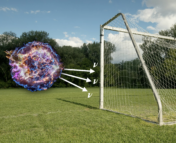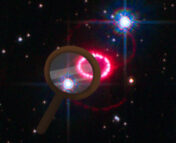Title: Constraints on neutrino natal kicks from black-hole binary VFTS 243
Authors: Alejandro Vigna-Gómez, Reinhold Willcox, Irene Tamborra, Ilya Mandel, Mathieu Renzo, Tom Wagg, Hans-Thomas Janka, Daniel Kresse, Julia Bodensteiner, Tomer Shenar, Thomas M. Tauris
First Author’s Institution: Max-Planck-Institut fur Astrophysik, Karl-Schwarzschild-Str. 1, 85748 Garching, Germany
Status: Accepted for publication in PRL
Towards the end of the life of a star over a few times the mass of our Sun, more and more elements pile up at the star’s center into a core of heavy nuclei that it can no longer fuse together. At a critical point when nuclear fusion can no longer support the core, it collapses under its own weight. This collapse can blow out the outer layers of the star, leading to a bright supernova explosion. Alternatively, the collapsing core can quickly swallow all the surrounding matter in its inception, emitting nothing from the implosion.
Or not quite nothing. What manages to escape are a few neutrinos, darting away fast enough to get free. This complete collapse is the end to a star’s life, and a new beginning to a black hole risen from the ashes.
Along with the massive explosion (or implosion), there is a potential for the newly born black hole to receive a speed boost — momentum transferred from the ejected matter and energy. The magnitude of the boost, or ‘kick’, is determined by the amount of ejecta in the explosion, while the asymmetry of the ejecta determines the direction of the kick. In the explosion scenario, ejected baryonic matter carries a large momentum and can cause a large kick of up to a couple hundred kilometers per second, potentially enough to rip an exploding star away from a binary companion. Meanwhile, the neutrinos escaping from a complete collapse are expected to carry away less energy and impart smaller kicks. However, it’s still not clear what makes a star implode rather than explode, or the true nature of how these kicks are imparted in a complete collapse scenario.

To understand more about these kicks, today’s authors look at a recent observation of a black hole orbiting a star, VFTS 243. Unlike black holes found with luminous x-rays, it is not pulling matter off of its companion. These non-interacting black holes are called inert black holes, and are discovered through their effects on the motion of their companion stars. VFTS 243 is special because it is the largest inert black hole observed so far, at 10 times the mass of the Sun, as plotted in figure 1. In addition, its orbit with its companion is extremely circular, indicating that this black hole could have originated from direct collapse.
Today’s authors use modeled stellar binaries which, given some kick velocity, ejected mass, and initial orbital period, result in the birth of a black hole in a new orbital configuration with its companion star. Comparing the observed orbital period, eccentricity, and overall velocity of VFTS 243 to these models, they can say what the most likely kick velocity and ejected mass was when this black hole was formed. They find that the black hole received a small kick at birth of just a few kilometers per second and lost less than one Sun’s worth of mass in the explosion, as shown in figure 2. If we assume that VFTS 243 formed by complete collapse, this constrains the impact of neutrino emission to small kick magnitudes. If there was also some baryonic matter ejected, this would make the contribution from the neutrinos even lower.

In addition, assuming that the black hole kick was exclusively from neutrino emission, they use the results on the kick velocity and ejected mass to calculate the asymmetry of the implosion. They found that the implosion was mostly symmetric, meaning that neutrinos were emitted in all directions during the formation of the black hole. A very asymmetric kick could have disturbed the orbital path of the black hole, resulting in a more eccentric system after black hole formation, and so the circular orbit we see supports the evidence that any kick should have been symmetric.
Simulations of complete collapse stellar explosions show that they result in small kicks to the black hole with little ejected mass. Knowing exactly what kind of black holes can start life from complete collapse in general is tricky, as it depends on the previous interactions of the stars in the binary system, as well as an element of the randomness of the Universe. With the observation of VFTS 243 being a key piece of the puzzle to link together observed evidence of complete collapse black hole formation with neutrino kicks to the theoretical predictions, the hard work continues in putting the whole puzzle together, and understanding the formation of all the observed black holes, including which ones are born quietly.
Astrobite edited by Kat Lee
Featured image credit: Storm Colloms




